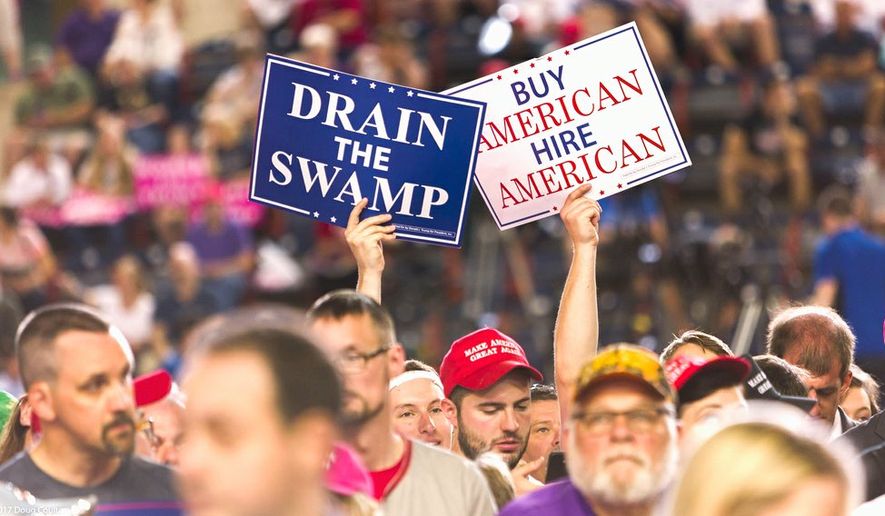NEWS AND OPINION:
President Trump could win the White House again in 2020 — which likely would send hostile political operatives and the disapproving news media into an epic meltdown. News flash: Get ready. Mr. Trump will likely win re-election, says one analyst.
“President Trump did not ascend to the White House in the usual way; he broke with traditional campaign orthodoxy and tactics,” Ford O’Connell, a political analyst and adjunct professor at the George Washington University Graduate School of Political Management, tells Inside the Beltway.
“While Trump’s first six months in the White House have been marked by early stumbles, a healthy dose of palace intrigue and low approval numbers, history says Trump is in fact the odds-on favorite to win re-election in 2020, should he choose to run. Why? Because presidential incumbency has its privileges. Since 1900, 20 presidents have sought re-election. Of those, 15 won and five lost — that is, if you include Gerald Ford, who was never elected in the first place.”
Adds Mr. O’Connell, “So how does President Trump avoid becoming the sixth president to be fired by the people in the last 120 years? Barring some unforeseen calamity or Dwayne ’The Rock’ Johnson becoming the Democratic presidential nominee, the fate of Trump’s presidency will live and die with the state of the economy in the fall of 2020.
“To ensure that the electoral winds are favorable to Trump, his administration must deliver results by passing tax reform before the 2018 midterms, showing significant progress on other key campaign promises: securing America’s borders, infrastructure, trade, conservative judicial appointees. He must also continue to instill in working-class voters in both the Rust Belt (Ohio, Pennsylvania, Iowa, Michigan, Wisconsin) and Sun Belt (Florida, North Carolina, Arizona) battleground states the belief that he is tirelessly fighting for them. If Trump does that, voters will forgive his impetuous ways and rehire him,” the professor concludes.
PESKY ’CHAOS’ JOURNALISM KEEPS BUZZING
The ever-inventive news media used the sudden departure of White House communications director Anthony Scaramucci as a springboard for creativity — offering minute-by-minute timelines and multiple ways to describe Mr. Scaramucci’s exit. He was sacked, fired, removed, “escorted off White House property” — that came from CNN — and resigned all on his own, according to different reports. There was also an eruption of the now familiar “chaos” journalism, using the event as yet another example of “chaos” in the White House.
But there was no chaos in the White House on Monday. Not at all.
President Trump took part in significant events that all went off as planned — and on camera. The afternoon press briefing took place, complete with Treasure Secretary Steven T. Mnuchin and National Security Adviser H.R. McMaster patiently explaining new financial sanctions against Venezuelan President Nicolas Maduro. Throughout it all, new White House Chief of Staff John F. Kelly — the man who has been at the epicenter of media squawking — appeared serene.
“As the news broke that Anthony Scaramucci will not be taking over as White House communications director so new Chief of Staff John Kelly can start with his own team, Kelly was in the East Room for a Medal of Honor ceremony,” noted John T. Bennet, of CQ Roll Call, in the White House press pool report. “He is seated in the second row of the center section on the right, and has been chatting with Treasury Secretary Mnuchin and others. He has been smiling and appears in good spirits.”
PRINCETON HAS A EUREKA MOMENT
“One Princeton University professor, concerned over the deep dearth of opportunities for students at the Ivy League institution to explore the principles underpinning conservatism, has decided to do something to help fix the problem. Philosophy professor Thomas Kelly will offer a freshman seminar this fall called ’Intellectual Foundations of Modern Conservatism,’” says a new report from The College Fix, a national student-written news publication.
“What first interested me in offering this particular course was my growing conviction that, in at least some respects, Princeton University is something of a progressive bubble, where students are not really exposed to the best arguments that can be made for various heterodox political and social views,” Mr. Kelly told the publication.
His course looks intense.
“We will attempt to better understand conservative thought, and develop a framework for assessing its strengths and weaknesses with respect to a number of representative topics, including: distributive justice, the role of the free market and the apparent tension between liberty and equality; the nature of crime and criminal justice; and social conservatism and the role of religion in society. We will also explore some broader conservative themes that appear repeatedly, including conservative critiques of ’good intentions,’ ’political correctness,’ and the political and cultural influence of intellectual and cultural elites,” Mr. Kelly writes in Princeton’s fall course catalog.
NORAD HAS A HELPFUL REMINDER
There may be constant fireworks in Washington, and movies bomb at the box office. Nuclear weapons are the problem elsewhere. Somebody’s got America’s back, however.
“North Korea’s launch on Friday of an intercontinental ballistic missile was detected, closely tracked and determined not to be a danger to North America. However, this provocative launch served as yet another reminder of North Korea’s continued threat to the United States and our allies with their missile program,” says General Lori Robinson, commander of the North American Aerospace Defense Command and U.S. Northern Command — that’s USNORTHCOM in the vernacular.
“I want to assure our citizens that USNORTHCOM remains unwavering in our confidence that we can fully defend the United States against this ballistic missile threat,” she notes. “We stand this watch each and every day.”
POLL DU JOUR
• 35 percent of the vote in the 2016 presidential election was cast by baby boomers aged 52 to 71 years; they cast 48.1 million votes.
• 26 percent of the election votes were cast by Generation X members aged 36-51 years; they cast 35.7 million votes.
• 25 percent of the 2016 votes was cast by millennials aged 18-35 years; they cast 34 million votes.
• 14 percent of the votes was cast by the “Greatest Generation,” aged 72 years and up; they cast 19.8 million votes.
Source: A Pew Research Center analysis of the 2016 Current Population Survey November 2016, released Monday.
• Nervous laughter, curious asides to jharper@washingtontimes.com
• Jennifer Harper can be reached at jharper@washingtontimes.com.




Please read our comment policy before commenting.